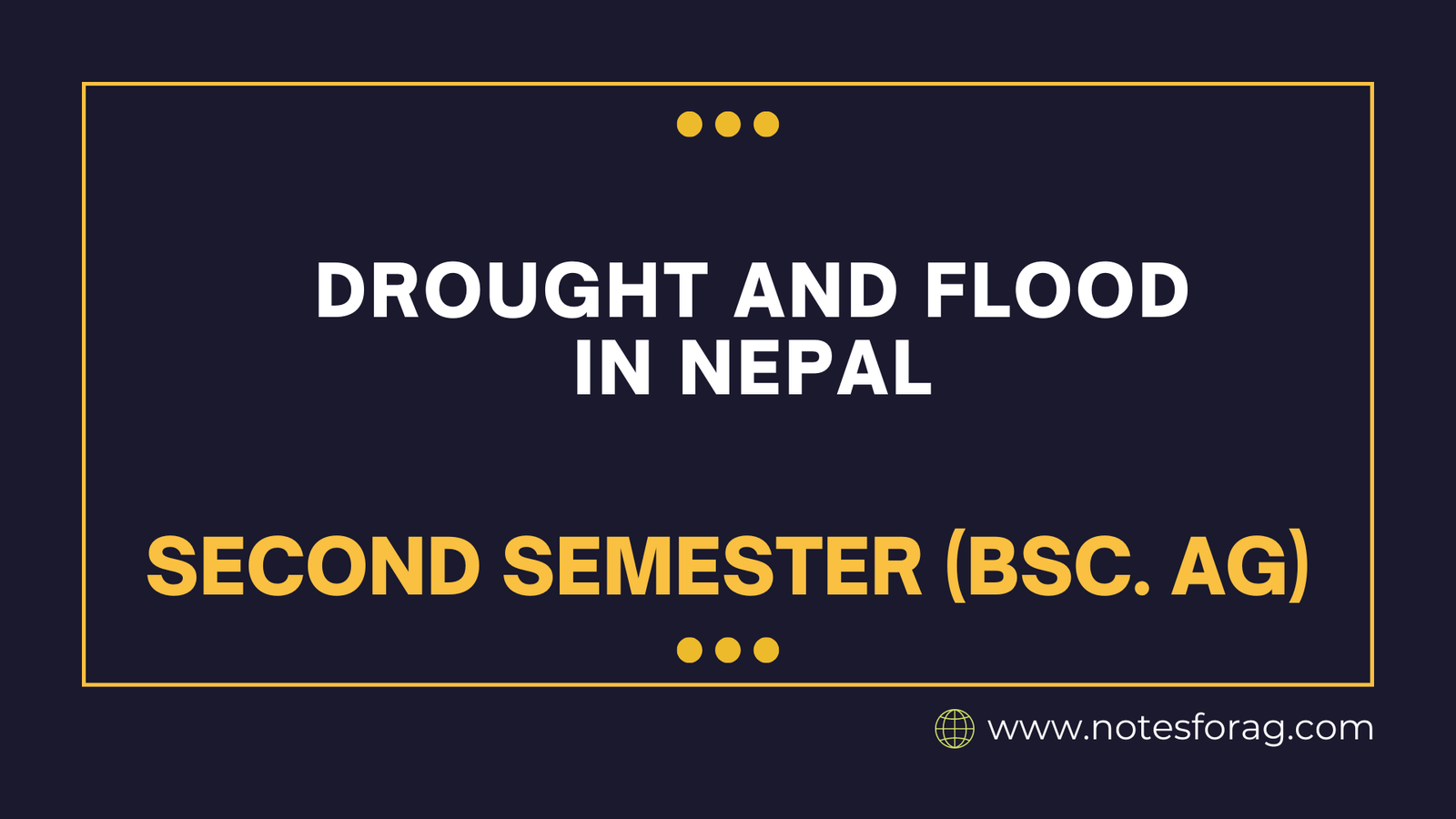In Nepal, drought and flood are two of the most major and common natural catastrophes that affect agriculture. Prolonged dry spells that cause significant water shortages that impact crop health and soil moisture are known as droughts. Floods severely harm crops, infrastructure, and means of subsistence. They are frequently brought on by heavy monsoon rains. Strong forecasting, management, and adaptation plans are required to lessen the negative effects of both phenomena, which provide significant obstacles to agricultural sustainability and food security.
Table of Contents
Drought
Drought is a lengthy period of exceptionally low rainfall that causes a water deficit. It causes insufficient soil moisture, which has a negative impact on crop growth, livestock health, and agricultural and home water supplies. Droughts are classified as meteorological, agricultural, or hydrological, with each having a distinct influence on the environment and civilization. Droughts of varying intensity and duration can result in major economic losses, food shortages, and long-term environmental harm.
Flood
Flooding is an overflow of water that submerges normally dry ground, generally caused by excessive rainfall, quick snowmelt, or dam failure. Floods can inundate agricultural areas, ruin crops, erode soil, and damage infrastructure, causing widespread economic and social disturbances. Monsoon rains are the principal source of flooding in Nepal, especially in the Terai plains and hilly regions. Floods can be characterized as riverine floods, flash floods, or coastal floods based on their origin and features.
Types of Drought
Droughts are complicated occurrences characterized by a prolonged lack of precipitation, which results in water scarcity. Droughts are grouped into three types: meteorological, agricultural, and hydrological. Each variety has a particular impact on agriculture and water resources, affecting crop productivity in different ways.
Meteorological drought: It is a lengthy period of below-average precipitation. It is the first sign of drought conditions and is distinguished by a lack of rainfall across a region. Meteorological droughts can diminish soil moisture, resulting in less water availability for crops. In Nepal, where monsoon rains are critical for agriculture, variations from typical rainfall patterns can significantly affect planting schedules and crop growth, resulting in lower yield.
Agricultural drought: It occurs when soil moisture levels are insufficient to support crop needs throughout the growing season. This type of drought is directly tied to plant water requirements and is determined by weather conditions, soil qualities, and crop water demands. In Nepal, agricultural dryness has resulted in wilted crops, delayed growth, and diminished harvests. Farmers typically struggle to maintain adequate irrigation, exacerbating the effects of drought on agricultural productivity.
Hydrological drought: It is characterized by the depletion of water resources such as rivers, lakes, and groundwater. It is usually caused by a long-term meteorological drought and has an impact on agricultural, industrial, and home water supplies. In Nepal, hydrological dryness can reduce water availability for irrigation, hurting both rain-fed and irrigated agriculture. Water level declines in rivers and reservoirs can have a knock-on effect on the agricultural industry, affecting irrigation capacity and crop production.
Major Drought and Flood Events Affecting Crop Production in Nepal
Some of the major drought and flood events affecting crop production in Nepal are:
Floods:
- 2017 Monsoon Floods: Severe flooding hit the Terai region, devastating crops and livestock and causing extensive damage to agricultural land.
- 2021 Floods: Monsoon-caused floods and landslides devastated several regions, resulting in significant crop losses and infrastructural damage.
Droughts:
- 2008-2009 Drought: Most of Nepal was hit by a severe drought, resulting in major crop yield declines, particularly in rain-fed agriculture.
- 2015-2016 Drought: A prolonged dry season in the mid-hill and Terai regions resulted in water shortages and decreased crop productivity, jeopardizing food security.
Drought Classification
Droughts are characterized according to the intensity and duration:
- Mild Drought: Short-term water shortages with little effect on crop productivity.
- Moderate drought: It is defined as protracted periods of dry weather that have a significant influence on water supply and crop productivity.
- Severe Drought: Extended periods of significant water scarcity, resulting in significant agricultural losses and economic consequences.
- Extreme Drought: Persistent and severe drought conditions that cause widespread crop loss, economic suffering, and environmental harm.
Aridity Index
The Aridity Index (AI) is a numerical indicator used to assess the degree of dryness in a given place. It is determined as the ratio of precipitation to potential evapotranspiration (PET).
Aridity Index=Precipitation/ Potential Evapotranspiration
- Hyper-arid: AI < 0.05
- Arid: 0.05 ≤ AI < 0.20
- Semi-arid: 0.20 ≤ AI < 0.50
- Dry sub-humid: 0.50 ≤ AI < 0.65
The Aridity Index aids in classifying locations based on moisture availability, which is critical for identifying drought conditions and planning agricultural methods accordingly.
Drought and flood in Nepal have a substantial influence on agricultural production, bringing difficulties to food security and livelihoods. Understanding the different types of drought and their classifications, as well as monitoring weather patterns with tools like the Aridity Index, is critical for designing effective mitigation and adaptation measures to deal with extreme weather occurrences. Improved forecasting, resilient agricultural methods, and water management can all assist to reduce the negative impact of drought and flood on crop production.
Frequently Asked Question(FAQ)
What causes droughts in Nepal?
Droughts in Nepal are caused by low rainfall, which can be aggravated by climate anomalies like El Niño. In addition, deforestation, soil degradation, and poor water management practices all contribute to drought severity.
How do floods typically occur in Nepal?
Floods in Nepal are mostly caused by high monsoon rainfall, rapid snowmelt, and glacial lake outburst floods. The country’s mountainous terrain and river systems render it vulnerable to flash floods and riverine flooding.
Related Articles

